#on top of the baroque churches
Text
Not that anyone on here cares anyway, but tomorrow at FUCKING 2:30 PM, in the middle of the heat, in the middle of the 38°C, in the middle of South Italy, I'll have my last big ass, scary, horrible, ass shaking, diarrhea stimulating, nails and lips' skin biting, hyperventilating oral exam.
I know I'll probably THROW UP the Christmas' meal + New Year's of three years ago.
But still...leaving this right here, because it's (ノ◕ヮ◕)ノ*.✧ pritti and because that's where I'm going to do the most splattering leap of faith of all times without an haystack underneath.
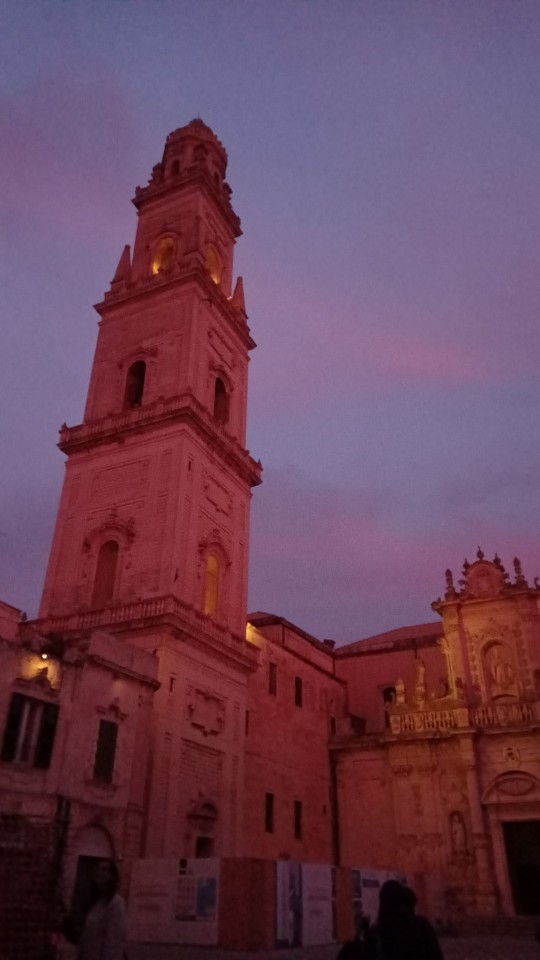
#pritti architecture#plus writing this post because why the hell noT PERCHÉ NO#I'm procastinating while I should take advantage of those hours for revising everything again bUT honestly#I'm DRAINED from all of my energies#a wise old sexy dilf of a man once said#requiescat in pace#amen I would add#ALSO this is off topic BUT#since I was little I ALWAYS have said that Ubisoft should make an Assassin's Creed game in my city#come on look at it#I always have imagined Assassins running on top of the Duomo we have here#on top of the baroque churches#hiding in the amphitheatre#COME ON UBISOFT DO YOUR THING#another AC in Italy would he refreshing and nostalgia would wash all over us#and you Ubisoft would have all the OG old fans in the palm of your hand#dai#UGH BUT ANYWAYS IM SO IN ANXIETY#I know I can do it but it's the most difficult thing a student of the last year of high school here can ever do for real😩😩#like another dilf once said#screaming crying and hyperventilating#wish me luck DIO BUONO#but as a wise old man once said#I make my own luck#my post
54 notes
·
View notes
Text
Say what you will about Van Helsing 2004; hate it, love it, be indifferent, But the All-Hallow's masquerade ball went sooooo hard and it had zero right to do so! It's a fun, campy, monster mash movie with wonderfully dated ( and expensive) cgi and non-stop action meant to be a popcorn flick one takes out to watch around spooky season. And it has this* chef's kiss* GORGEOUS 6 minute sequence plopped arbitrarily in the second act, which unexpectedly surpasses nearly every other ball in the last 30+ years of film( notable exception being the Cinderella 2015 ball) for literally no reason other than to be dramatic af.
Like feast your eyes on this Gothic masterpiece!!! Who doesn't want to immediately live in this picture?!??
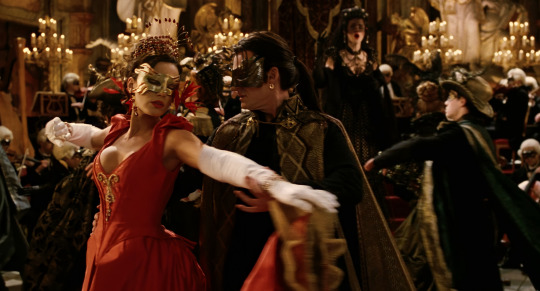
They used those candles with oil in them so that they would have real candles, real string orchestra( I believe), probably around 100 real life extras( something which is tragically absent in modern film), said extras are all in beautiful fully decked-out costumes( which are in luxuriously dark colours, but nearly no fully black, another thing you cannot say for much modern cinema), REAL CIRQUE DU SOLEIL PERFORMERS for all the acrobatics!!!! Hell, instead of filming in a sound stage, where they could control the reverb and the acoustics and the size of the set and the bloody lighting ( they apparently had a heck of a time emulating the firelight for this sequence) and the temperature( it's very cold in stone churches!) better, they filmed in a Baroque church in Prague! As I said, peak dramatic splendour, jfc...

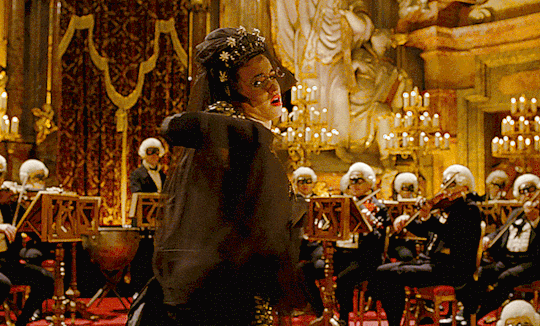

Think about that a second...They filmed a vampire masquerade in a Baroque Catholic Church( St. Nicholas' in Lesser Town, if you were curious) with amazing over-the-top acoustics and marble statues and real, tiled floors and marble pillars and a choir loft which they very much utilized, covered the pipe organ and the altar with a grand brocade curtain so it wouldn't be so obviously a, you know, a church! And there's a gold gilt elevated and canopied pulpit into which they put two vampire kiddies for, again, the sake of being dramatic.

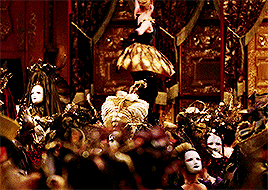
And the costumes! They remind me of the 25th anniversary Phantom of the Opera Masquerade costumes. Same quality, like they're old, well-cared-for costumes pulled out of a warehouse, instead of fast industry churn-outs. With lots of trim and colour and masks and lace and feathers and..just...ugh.. they are all perfect! Just look at all the head pieces on the ladies and the hats on all the gentleman ( save Dracula of course) and the powdered wigs on the musicians. ANNNNDD! The dresses are historically correct!!!!!! It's the 80's bustle era! Nobody does the 80's bustle era in film anymore and it's a bummer. Oh and one other thing! Anna's ( and other women's) hair, at least here in the ball, is also historically accurate because it's all pinned up! None of those fucken modern beachwaves at a ball! Everybody's got updo's!
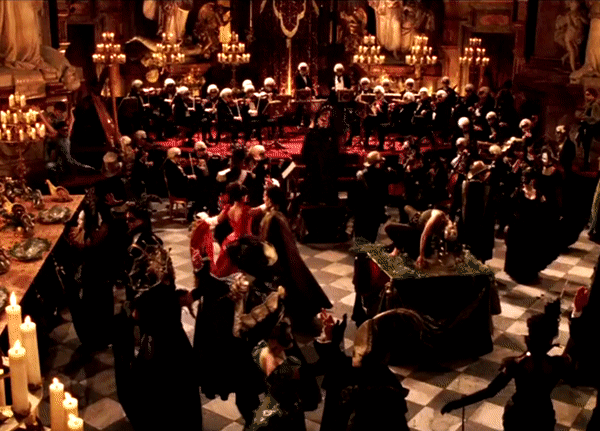
Gah, I swear, Dracula in his gold cloak really does things to me in this scene!

By the way, the acrobatics are bonkers in here for just background stuff!! Especially the random guys on unicycles and the dude playing the violin whilst standing on a ball...Like....WHAT?
Anyways, all this to say, that this masquerade ball feels sooo real and tangible and because of that it blows every other film out of the water, and no, I will not change my mind!!!!!
Here's a few more gifs, bcuz, why the hell not, this scene is sexy as fuu*ck?
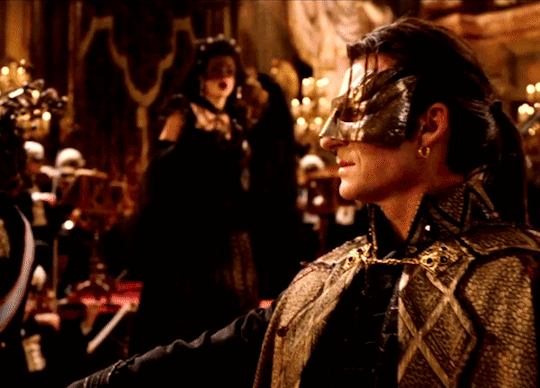



Alright I need to go to bed now.
#van helsing#van helsing 2004#dracula#count dracula#cinderella 2015#I'm on a film rant#masquerade ball#vampire#vampire masquerade ball#practical effects#costumes#gorgeous gorgeous set#baroque church#count vladislaus dracula#cirque du soleil#WHY IS THIS SOOO GOOD????????#princess anna valerious#kate beckinsale#richard roxburgh#phantom of the opera 25th#very phantom of the opera-esque
2K notes
·
View notes
Text

Valletta, capital city of Malta, is located on a peninsula between Marsamxett Harbor (top) and the Grand Harbor. It is the southernmost capital of Europe, and at just 0.24 square miles (0.61 sq km), it is the European Union's smallest capital city. Valletta is noted for its historic fortifications and its Baroque palaces, gardens and churches.
35.898333°, 14.512500°
Source imagery: Maxar
265 notes
·
View notes
Photo

Check it out- Beyonce and Jay-Z bought this Baroque former church in New Orleans, then put it up for sale under a cloud of mystery. It has 7bds. 8ba. and was built in 1927. For instance, why did the asking price jump by $1 million, from $3.5M to nearly $4.5M, after less than a week on the market?
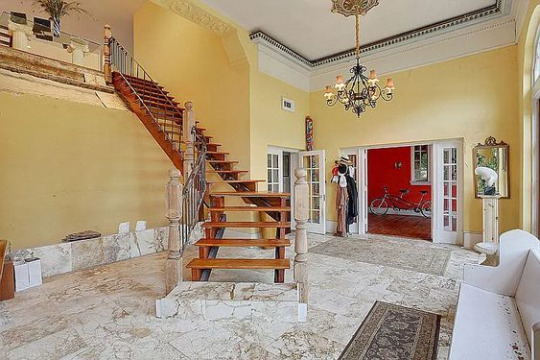
The foyer and stairs. (It was a ballet school before being converted to a house in 2000.)

These interior pics are from 2015 b/c the house was damaged by an alleged arson fire. Who started the fire, and why?

Why is the place listed as an FSBO (for sale by owner), but the owner’s phone number is a Mississippi-based immigration attorney?

The listing also tells buyers to visit a certain property marketing website, but the site doesn’t actually exist. The ornate Spanish-style structure is also fully blurred on Google Maps.

They own it, but never actually lived in it. However, the sellers have offered to paint the structure the new owner’s choice of color before the deal closes.

The church has 1 main residence and 3 apts. Zillow has the exclusive listing and now it’s off the market.

It’s unclear if these spaces have been altered in the past few years. The kitchen is dated.

This is an office or studio.

2nd fl. vestibule library.



The main bd. with en-suite and walk-in closet.


Guest room and en-suite.

2nd guest room.

3rd fl. loft sitting area.
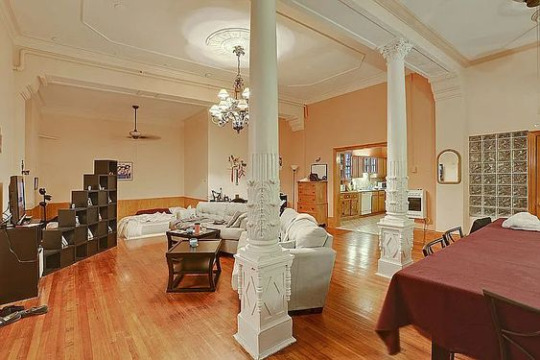

One of the 3 apts.



This apt. is in the garden. Notice the Mardi Gras beads above the island.

And, this is an apt. in the chapel loft.

Roof top garden and gazebo.
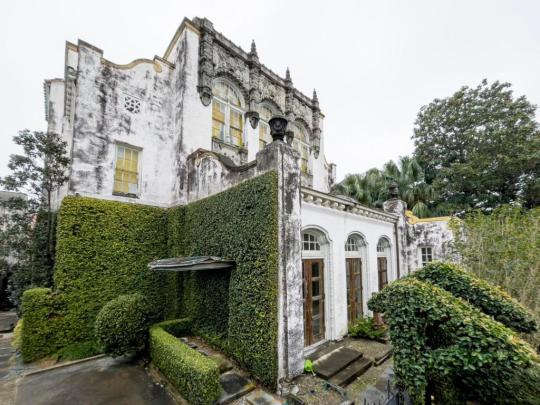
It’s covered with very neatly trimmed ivy.
https://www.zillow.com/homedetails/1527-Harmony-St-New-Orleans-LA-70115/73821552_zpid/
https://www.hollywoodreporter.com/lifestyle/real-estate/beyonce-jay-z-new-orleans-church-real-estate-1235035503/
#beyonce's NOLA converted church#church conversion#old house dreams#houses#house tours#home tour#long post
117 notes
·
View notes
Photo

St. Ignatius Church through the trees on Charles Square, Prague (infrared photography)
The church was designed by Carlo Lurago in the early Baroque style, and built between 1655 and 1677. The church was built as part of the new Nove Mesto residence of the city's Jesuits, the third largest Jesuit complex in Europe, and dedicated to their patron saint and founder of the Jesuit Order, St. Ignatius of Loyola.
The top of the facade carries a statue of St. Ignatius Loyola, placed there in 1671, with a halo surrounding his whole body. This feature was considered controversial at the time it was installed, as such a decoration was only considered appropriate for statues of Jesus Christ.
#photographers on tumblr#original photographers#black and white#infrared photography#trees#church#st. ignatius church#kostel svatého ignáce z loyoly#karlovo náměstí#charles square#st. ignatius of loyola#jesuits#praha#prague#baroque#infrared
72 notes
·
View notes
Text

‘But you,’ he said ‘who do you say I am?’ Then Simon Peter spoke up, ‘You are the Christ,’ he said ‘the Son of the living God.’ Jesus replied, ‘Simon son of Jonah, you are a happy man! Because it was not flesh and blood that revealed this to you but my Father in heaven. So I now say to you: You are Peter and on this rock I will build my Church. And the gates of the underworld can never hold out against it. I will give you the keys of the kingdom of heaven: whatever you bind on earth shall be considered bound in heaven; whatever you loose on earth shall be considered loosed in heaven.’ [Matthew 16:13-19]
On 22 February we celebrate the Feast of the Chair of St Peter to honour the authority of the St. Peter and his contribution to the Church.
The original chair was believed to be made of oak wood and according to legend, St Peter used this chair to deliver his sermons.
Bernini was entrusted with creating a cover to preserve the chair. The design was ornate in tradition with the baroque-style popular at that time. He incorporated messages from the Bible and symbols of Papacy in the structure.
The sculpture's base contains the life-size statues of four Doctors of the Catholic Church: St Ambrose, St Augustine of Hippo, St John Chrysostom, and St Athanasius.
Angels appear on both sides of the symbolic bronze chair guarding the wooden chair behind. A pair of Cherub angels sit on the top of the chair while holding the keys of St Peter’s in one hand and supporting the Papal tiara, which is placed directly above in the air, in the middle of the chair.
The structure has the backdrop of a golden alabaster glass window. It's decorated with statues of playful angels in the clouds. At the centre of the window is a dove, a symbol of the holy spirit. The window pane is divided into twelve sections to pay tribute to the Twelve Apostles.
#lectiodivina#scripture#catholic#christianity#carmelite#carmelites#prayer#faith#spirituality#kingdomofgod#goodnews#godslove#forgiveness#peace#hope#love#courage#stpeter#pope#vatican#gospel#jesus#christ#truth#holyspirit#lightofchrist#healing#saint
3 notes
·
View notes
Note
Idk if you were asking about American churches specifically (if yes feel free to ignore this, I just like talking about religious differences and giving my opinion), but the churches where I grew up (Southern France) were not as heavily decorated as baroque churches. So I tend to be uncomfortable in very decorated churches, bc I was taught the house of God was supposed to be nice, but still humble. Like you can have stained glass and statues of the saints + Mary and they are pretty tbh but to me heavy decoration is just flaunting and sort of being vain. I hope this makes sense???
it does make a lot of sense, I mean, that's. part of why protestantism exists, because the Catholic churches were way too over the top (along with 98 other things /j)
I completely understand why, coming from a place of a less decorated place, seeing a church be covered in gold plate would be jarring - I think it's a reflection of what you were taught was the way you should think of god (humble and close or personal to the people versus very distant and not-personal)
#I summarise it as The god of protestants (and similar) is an everpresent overbearer and the god of catholics is an absentee neglecter <- taking this out of my own tags because I stand by it
#I summarise it as The god of protestants (and similar) is an everpresent overbearer and the god of catholics is an absentee neglecter#[.asks]#anonymous#religious trauma#<-not specifically but i am : organising my blog
36 notes
·
View notes
Text
Why WARRIOR NUN is the ultimate homage to Female Sainthood and why you should care
OK this is going to be longish series as I have so many opinions. The show has revived my love for all things female sainthood and relics and all that holy stuff.
As a fantasy series embedded within Roman Catholic Reformation ideas and refracted through the baroque aesthetic, it is deliberately too much. Too hyperbolic. Like adolescent girls losing their shit over their latest crush the TV show is just way way over the top in the very best way.
This is where high and low culture mashes together into a gorgeous multi-layered lasagna of meaning. I love how the show doesn’t give two hoots about cultural hierarchies.
I wrote a PhD about female sainthood way back in the Ice Age. In particular, I loved how some of the brightest and best of these women transgressed, breaking tons of papally sanctioned rules and generally went fuck the status quo and clerical authority.
First, a little primer in how to view the world with a medieval perspective. It is often refracted through lenses we would term as allegorical and fantastical.
There are some Italian scholars that hold that all the reports of demons, angels and dragons were due to everyone being basically either drunk or high. Water awash with bacteria was going to kill you. So in the West to make it sterile it was brewed, ecoli being no match for alcohol. Everyone,everywhere, and much of the time, was inebriated.
In particular, the argument goes that the majority of the European population also ate some form of rye bread which was contaminated with fungi that had hallucinogenic properties. In essence, people swallowed the fantastical stories while supping on their daily portion of magic mushroom bread.
I happen to think this is too reductivist. They lived in a world where scientific thinking as we understand was long forgotten and epistemologically remote that it is yet to be discovered. The Enlightenment, Renaissance thinking and scientific discovery were a couple of hundred years off.
Further, all written communication is within the monopoly of the educated religious elite conversing with each other in Latin. The Church dictated terms of reference of life to the rest of the population for about one thousand years. The super highway of thought was copyrighted in its entirety by the Catholic Church.
It was not a con trick. The medieval thinker just approached what they saw and felt through inductive rather than deductive reasoning. Interpretation starts from the premise of where have I seen this before?
The monkish scholars would run to the library and consult works that clued them in on what they observed in the world around them. They applied their scholarship within terms they found familiar and reassuring and therefore real. Remember this: distinguishing between inductive and reductive thinking will help you understand the medieval mindset on its own terms without our modern judgements cluttering up their view of the world.
The second most important thing to remember and something the TV series does so well is that the veil between what is corporeal, ie of this world, and incorporeal, not of this world and sometimes interpreted as spiritual, is wafer thin.
It is a credit to the medieval imagination that they could escape into their minds when the reality of existence is that of subsistence and survival for the vast majority. Let’s take how circumscribed their geographical limits are as an example.
In a short lifetime of 30 years, if you are lucky, the distance travelled and your world in probably about a days walk. We are talking 15 miles max. If you have a horse a bit further. In practical terms, that meant your home, the land you worked, where you paid your tithe to the local lord and the market place which was extra exciting on high days and holy days.
So in this landscape apart from the local lord’s manor or barns the largest edifices on the landscape was the churches. Unlike your wattle and daub shitty house, it was made from the latest materials of dressed stone and vaulted in tufa. The spire dominated the landscape. Its bell regulated your day. On a Sunday you would sit in the nave staring at the judgement fresco showing heaven and hell while a priest intoned something magical in a language that was incomprehensible as a sign of who was spiritually and materially dominant.
Areala, Ava, Lilith and all the halo bearers are not merely a fictional exaggeration to the medieval populace. They come out of a cosmography of sainthood and female communities that are insanely muscular in ambition compared to our expectations of what women can achieve. Current girl power and ambition is anaemic compared to what those women wanted then.
Hey, girl, in the twenty first century you can be whatever you want- a CEO, a doctor, an anodyne influencer of your fellow tik tok addicts; the president of the US (oh hang on that one is still buffering)
The saints’ lives are a written cornucopia of all the slayers of dragons in powerful men. Women who wanted and got so much more and were written up in lore. Statues were erected in their honour. Communities were founded in their name. And little men who overawed and slightly freaked out tried to keep up and tell their stories in a more palatable manner.
There are literally thousands of examples recorded and collected by the Catholic church. So far as ten thousand and counting. The project in earnest began three centuries ago when the church’s response to the Protestant Reformation was to double down on the stuff for which they were excoriated by their more pious and puritanical critics.
- preposterous claims of ability of items of dubious provenance to cure ills ie relic collection and pilgrimage.
- the miracles performed by the elite of the church ie those proposed as saints in an attempt to assert the dominance of the spiritual over the material world.
The church came out of the closet on this. Actually it sashayed down the religious runway of hyperbolic campery in all its baroque finery. The Roman Catholic church were telling their opponents that their worship was just so much cooler than the pared down asceticism currently doing the rounds. And they used and promoted their saints to provide a techni-coloured ultra saturated with spiritual dynamite exemplars.
As a preview I want to pick a few female examples from this rich tapestry and discuss how they relate to all things Warrior Nun. The ones we can do some more in depth analysis on are
Margaret of Antioch Slayer of Dragons. Enough said
Hildegarde of Bingen. I give you the ultimate Medieval Renaissance woman. Medic, composer, mystic, scholar, abbess, counsellor to kings and popes. Worked out how blood ciculated through the body five hundred years before a dude took credit for it. She came line of women who liked telling the pope off starting with Mary Magdalene and including Catherine of Siena
Joan of Arc; proto Ripley taking on the alien English for the namby pamby Dauphin.
Benedetta Carlini. The poor Florentine scribes seriously lost their shit over her. The church authorities were investigating in the seventeenth century for potential beatification In a series of interviews, her doings in the abbey with her companion cause so much scandal. It had them reversing that process so fast everyone got monastic whiplash. Ignore the Verhoeven version; it is shit and doesn’t do her justice on any level.
24 notes
·
View notes
Note
Do you think Daisya abd Marie could start a band with Charity Bell and Noel Organon as the insturments? XD
100%!! The question is whether Marie would be willing to wrangle Daisya into practice.
Now, they’d be a mean accompaniment to your average church music (choir, carillon, organ), but I’d say they need percussion for a band! Daisya seems like he has the personality for it. Unfortunately, he’s only got two hands. Maybe he does the chimes with his feet and plays percussion up top. After all, organists typically play with feet and hands at the same time. Not unheard of! They’d be a great tenor/baritone duo. Though I’d imagine Daisya’s singing voice is closer to Perishing Alt Rock than Bel Canto.
A third or fourth member(s) would be helpful to have around. Better—make it a five man band. Kanda on bass (lmao), Allen on keyboards (fourteenth), Lenalee on lead guitar (she keeps the band together), Marie on vocals and…whatever his actual instrument is, Daisya on drums. Composition…let’s say that Allen and Marie would handle most of it with Daisya assisting (he comes up with the riffs, but no way he is going to write them down).
I couldn’t tell you what genre they’d play. Daisya strikes me as an alt rock guy to the core, more along the second wave punkish side of things à la Offspring. Marie on the other hand might be a Baroque who dips into dark ambient. Not the most compatible genres! Splitting the difference, I think they’d be great doing symphonic rock/metal. Something along the lines of Yuki Kajiura’s Fate/Zero and Madoka Magica OSTs! Magia (PMMM ED) in particular uses chimes to great effect.
#anyone have any other thoughts. love the gang. I love to think about them#kelsey liveblogs d gray man
6 notes
·
View notes
Text
"Miserere mei, Deus” by Gregorio Allegri
Gregorio Allegri (c. 1582-1652) was a late Renaissance composer, best remembered for his ‘Miserere’ for two choirs. Allegri began singing in San Luigi dei Francesi before joining the Sistine Choir in 1629. Renaissance music was built upon plainchants, and is characterised by polyphony, imitation, motets, superimpositions, and overlapping cadences that convey flow, expressiveness, and devotion. ‘Miserere’ exemplifies Renaissance polyphony—one choir of five voices sings a fauxbourdon of a plainchant for the Tonus peregrinus, while the other choir of four voices supplies with elaborations and cadenzas, forming a 9-part polyphony.
youtube
Sistine Codex of 1661
‘Miserere’ is an acapella performed exclusively during Holy Week in the Sistine Chapel for ages. The church forbade it from being transcribed, so while the original 1661 codex might not reflect the true composition, it reveals the secret ornamentation practice of the olden Sistine Chapel Choir.
The Sistine Chapel Choir is a permanent choir in the chapel that never sings with instrument accompaniments. In this historical recording, a group of voices sings the plainchant, and then a second group of voices responds with elaboration. This repeats four times, as Allegri intended. The two choirs are distinct—even without video, one could picture that the second choir is singing far away at another end of a massive room. While I appreciated the contrast as it dynamised the plainchant, the upper voices in the second choir had drowned out the lower voices, resulting in an “airiness”. Nonetheless, the voices were well-blended and captured the essence of Renaissance music—the melodies flowed smoothly with no fixed tempo, and the music was expressive, whereby the soft tenor solos sounded pleading, but the choir in tutti sounded haunting. ‘Miserere’ means "Have mercy on me, O God" in Latin; fittingly, the acoustics of the chapel allowed their voices to echo, amplifying their devotion to God.
youtube
King’s College Choir 1963
The world-famous Choir of King’s College, Cambridge sings in the King’s College Chapel. This is one of the first modern recordings, conducted by David Willcocks and featured soloist Roy Goodman. It differs vastly from the original—during the 19th century, ‘Miserere’ was incorrectly transcribed, transposing the solo choir up a fourth.
Although sung in English, this version still preserved the smooth melodies and distribution of rubato in the original 1661 codex. However, it is more textured, dynamic, and exciting. The articulation of words is clearer; the tenors used a higher vocal placement to produce a more lightweight sound; the basses were audibly growing louder and softer, shaping a slow push-and-pull melody; the boy sopranos pierced through with their resonance and agility in the ornamented lines. Nevertheless, the pièce de resistance is boy treble Goodman’s breath-taking high notes during the second half of the four-voice falsobordone. Though his entry was a little shaky, the transition to the “top C” note was slick and precise, with a slight crescendo and close-to-none sliding. It is astonishing how Goodman sustained those notes—four times—without sounding strained; his pure and aethereal voice quality cannot be replicated by a female soprano. The high notes are my favourite part in contemporary ‘Miserere’, and I have yet to hear one as moving as Goodman
youtube
Ofra Harnoy
Ofra Harnoy is a widely celebrated classical cellist with over 40 solo albums. This recording is part of her ‘Back to Bach’ album, filled with Baroque favourites. Harnoy’s vision was to design a large cello ensemble by herself. To attain that effect, she harnessed the power of technology to overdub and produce multi-tracks.
I thought Harnoy’s work was innovative—the mixing and mastering were done so well that with eyes closed, her arrangement did seem like a grand cello ensemble. The tempo was a bit slower than the original 1661 codex and King’s College Choir 1963 recording, but that allowed the strings to ring longer, hence extending the crescendos and decrescendos. Additionally, the lower parts are more discernible than in the previous recordings. The rich bass and use of vibrato dramatised the music, creating a hauntingly beautiful and poignant experience. The high notes did not overpower, unlike in the King’s College Choir 1963 version, hence highlighting the polyphony.
One might think that Harnoy made her cello sing, but I felt that she transformed ‘Miserere’ into a cello piece. My only critique is that all the verses should have been recorded, to demonstrate how each verse differs in the embellishments—for example, the appoggiaturas sung by the higher sections.
youtube
Montechait
Montechait is a YouTuber who does piano cover videos and arrangements. He played on a Studiologic SL88 Studio keyboard, then produced and edited the audio using Pianoteq and Cubase software.
The pitches were not the most precise in the original 1661 codex and King’s College 1963 recordings. Hence, the pitch-perfect keyboard demonstrated how the melodies could sit with one another to deliver chords that assert gloom. I enjoyed that the ending verse was in forte, emphasising the volume of a 9-part polyphony. But this performance lacked expressiveness, which is quintessential to Renaissance music. Despite Pianoteq being one of the greatest virtual instruments that simulate the playability of an acoustic instrument, the recording had a largely manufactured sound. Furthermore, the piano is limited in the expressive shaping of notes as it does not offer dynamic nuance or vibrato.
I learnt that every performer has a unique story to tell in ‘Miserere’—whether it is of worship by the Sistine Codex of 1661, of tradition by the King’s College Choir, of beauty by Ofra Harnoy’s soul-stirring cello, or melancholy by Montechait’s solemn keyboard. In my opinion, the key change from G minor to C minor—due to scribal error—echoes the famous saying: “There are no mistakes, just happy accidents.” ~Bob Ross.
#music appreciation#critique#critic#school assignment#essay#student#Miserere mei deus#Gregorio Allegri#late renaissance#choir#song#church#choral#Sistine Codex of 1661#King’s College Choir 1963#Ofra Harnoy#Montechait#classical music#youtube#music#singapore#Youtube#roy goodman
2 notes
·
View notes
Text
Buda Castle
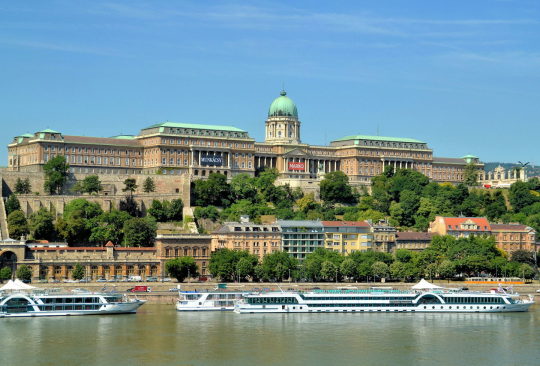



Buda Castle is located in Budapest, Hungary. Built in the middle of the 13th century to defend against Mongol invasion. The castle is one of the biggest in the world. The palace complex covers eleven acres and is positioned on top of Varhegy Hill overlooking the Danube River, the Chain Bridge, and the Pest side of the city. The castle was destroyed and added to throughout its long history, but only a fragment of the medieval palace survived the destruction of 1686-1715. It’s surrounded by a Neo-Baroque fence, while the interiors include barrel-vaulted ceilings, a Gothic Hall, a Gothic balcony tower, St Mathias Church, St Stephen Hall, a medieval cellar, and the King’s cellar. Beneath the castle is a labyrinth of caves and tunnels that lead to Sandor Palace. A National Library, the History Museum, and the National Gallery are on the property. Although some structures underwent restorations at the end of WWII, part of the castle remains destroyed, with many elements plundered. In 1987 Buda Castle became a UNESCO World Heritage Site.
3 notes
·
View notes
Photo
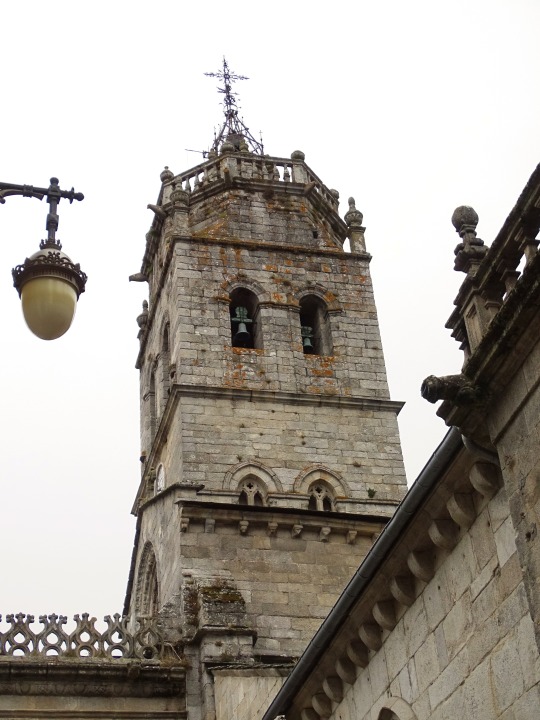
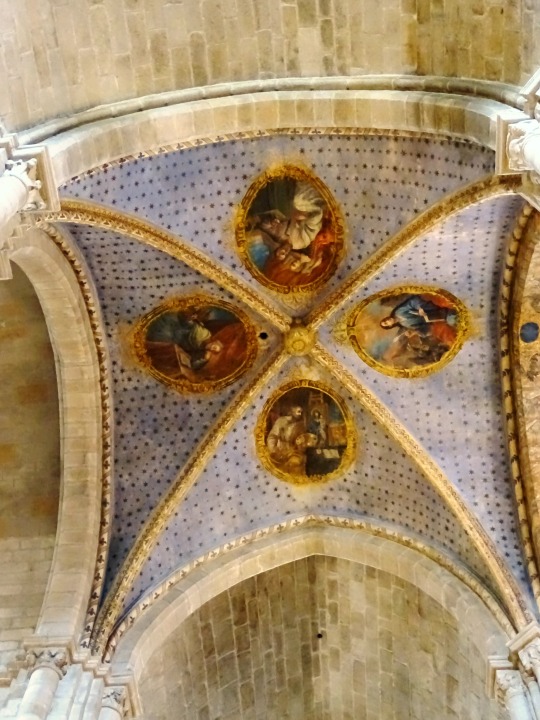
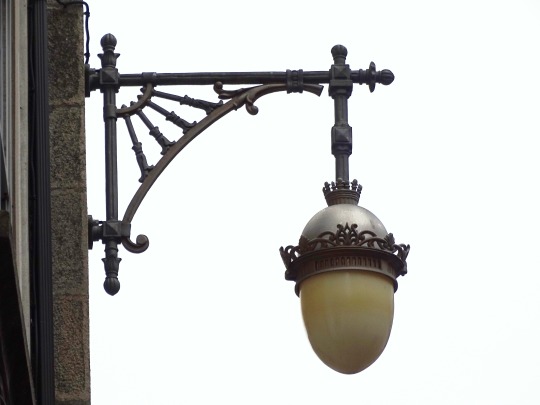

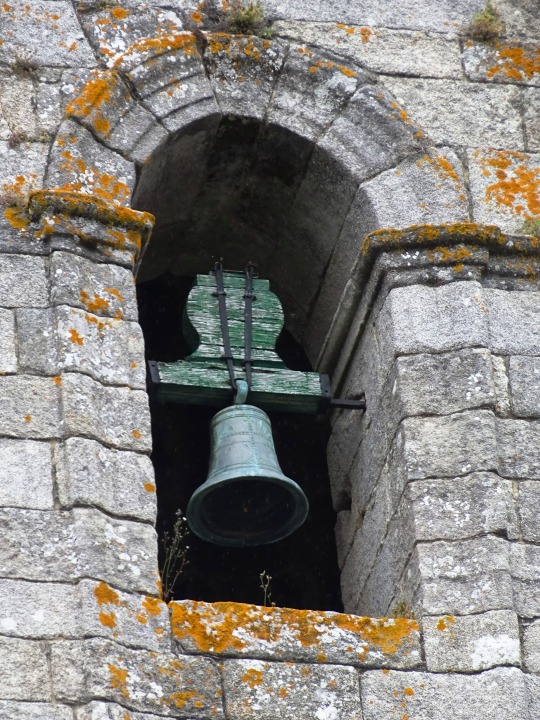


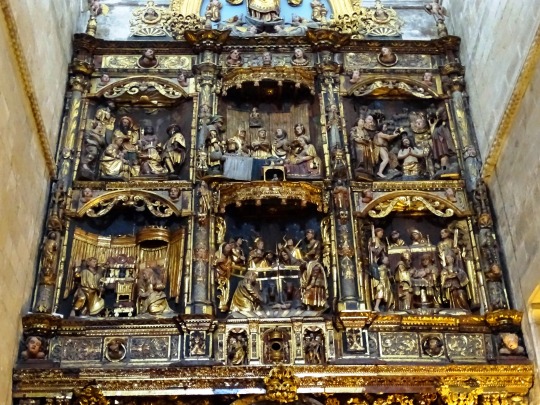
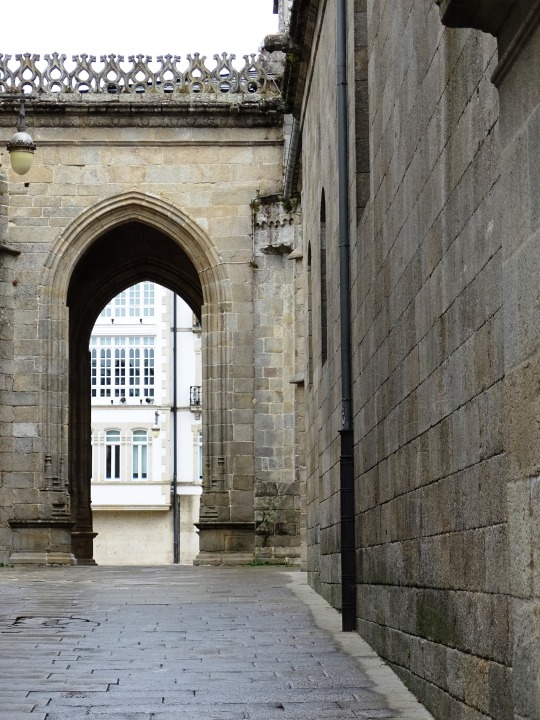

Saint Mary's Cathedral, Lugo (No. 4)
The cathedral has a Latin cross plan with three naves, transept and ambulatory with five apsidal chapels.
The main nave is covered with a pointed barrel vault and the sides with a barrel and edge vault, with ribs in the transept, and a barrel vault with lunettes in the clerestory. The clerestory windows are of acute arch or pointed to the interior and exterior.
To the left of the entrance to the cathedral is the Old Tower, Gothic, topped by a body of Renaissance bells, the work of Gaspar de Arce in 1571.
In the Plaza de Santa María, at the head of the cathedral, there is a cruise of unknown date, in the section that goes between the bell tower and the chapel of the Virgen de los Ojos Grandes.
The vertical walls and vault of the nave of the transept are Romanesque, as are most of the main nave, lateral and clerestory, whose vaults were remade in the eighteenth century.
The first body of the main chapel and the ambulatory with its attached apsidal chapels (1320-1360), except for the central one, belong to the Gothic, as well as the old ones of Santo Domingo de los Reyes (1370) and San Froilán (1480), which currently form the call of the Pilar, in addition to the first body of the bell tower (around 1570 or before) and the narthex or north portico (1510-1530), Not so the cover.
The second body of the main chapel and the current chapel of San Froilán are Renaissance; to the Baroque belong the sacristy (1678), the chapter house and its surroundings (1683), the cloister (1714) and the central chapel of the ambulatory, called the Ojos Grandes (1726).
The main façade, on the other hand, corresponds to a project in neoclassicist style of the late eighteenth century, whose author was Julián Sánchez Bort. This project moves in the orbit of what Ventura Rodríguez proposed for the façade of the cathedral of Pamplona, which in turn includes the turreted church scheme proposed by Serlio. The completion of the façade took place in the late nineteenth century, with the finishing of the two towers. These correspond to a design by Nemesio Cobreros inspired by the original project of Sánchez Bort.
Source: Wikipedia
#chapel of the Virgin#transept#Saint Mary's Cathedral#Lugo Cathedral#travel#Catedral de Santa María#Romanesque style#architecture#cityscape#Lugo#exterior#interior#original photography#vacation#summer 2021#España#Spain#Northern Spain#Southern Europe#A Mariña Occidental#Galicia#tourist attraction#landmark#tower#lantern
8 notes
·
View notes
Text
Naples (5): On the benefits of being bombed

The story so far: after 36 hours in the heart of Naples, we still hadn't found the smart side of the city.
In the nomenclature I had devised, we'd seen plenty of Nablus and were looking for Neapolis.
We went on our quest by public transport. Metro trains in Naples definitely belong to Nablus.

But when we got off at Municipio, after just two stops, there was a change of scene.
What caught our eye was not so much the sleek design – modernism tends to age quickly – as the medieval fortifications embedded within the station.
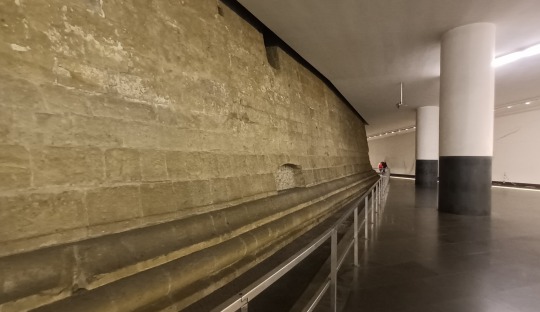
This, an information panel explained, was part of the "Aragonese citadel" built by the Spanish warlord who wrested the Kingdom of Naples from some French big cheese in the 1440s.
This section of the fortress was revealed during excavations for the metro line.
We emerged into a square dominated by a fountain (pictured at the top). The water feature representing Neptune, Wikipedia informed me, was erected around 1600. Neapolis indeed!
A short distance away was a shopping gallery that puts any Milanese arcade in the shade.
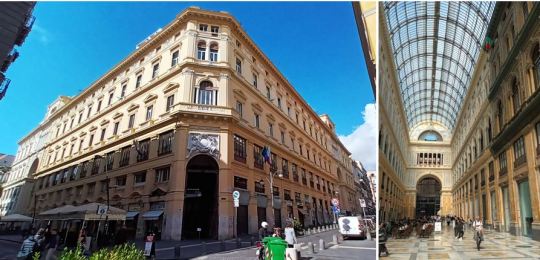
The Galleria Umberto I was built in the 1890s. I later found out that it lies within Naples' World Heritage site, along with the crumbling historic centre.
I can't help but think that Unesco honoured the Centro Storico because they had to, but recognised this gallery because they WANTED to.
Our morning walk was growing more Neapolitan by the minute. We strolled up Via Toledo, a salubrious shopping thoroughfare.
A funicular terminal led invitingly to elegant heights to our right. But we had not exhausted these parts, so we pressed on and made a mental note of the funicolare for later.
Further up we found two churches facing each other. The Chiesa del Gesù Nuovo, the local Jesuit headquarters, is frankly a dog's dinner.
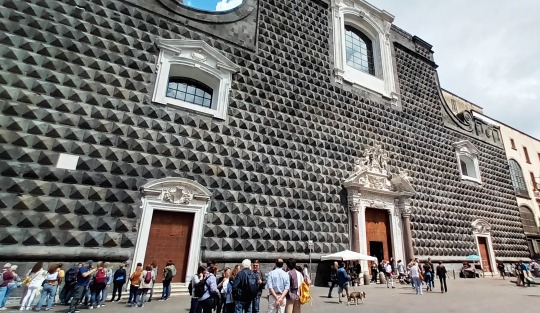
Built around 1750, the church takes Baroque extravagance to ridiculous heights. Behind the bizarrely spiky façade lies this interior.
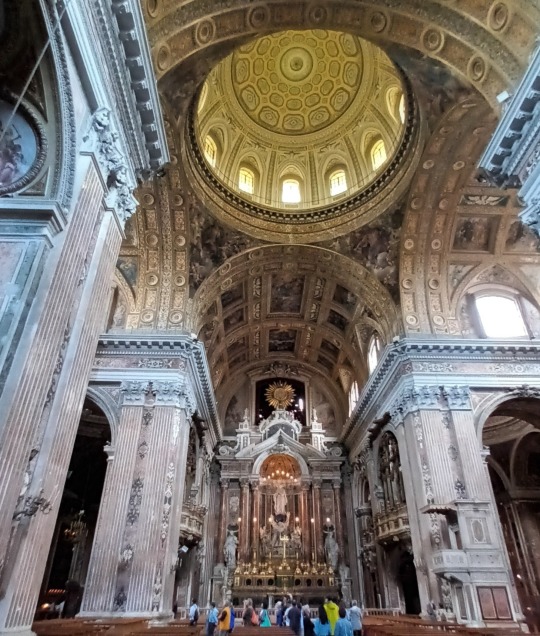
Still, Gesù Nuovo is worth checking out, if only to contrast it with the church next door.
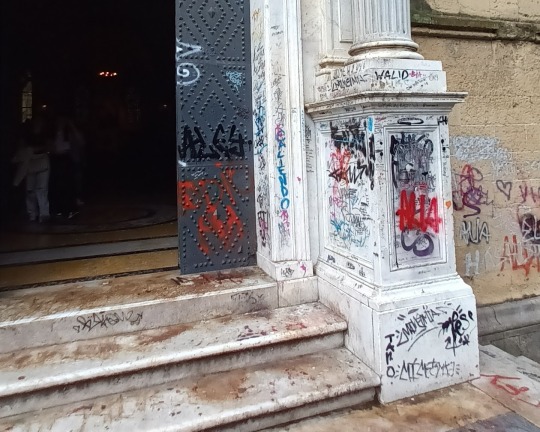
The entrance of Basicila di Santa Chiara may not look like much but inside, soaring splendour awaits. To appreciate its magnificence, a bit of history is in order.
The church was built in the 14th century in the Gothic style. It was dedicated to Chiara of Assisi, who had founded a monastic order a century earlier (more on this remarkable saint below).
The basilica and the adjoining monastery form the Complesso Monumentale di Santa Chiara.
In the 18th century, the complex was regarded as too boring and redecorated in the Baroque style. It remained in this gaudy form until World War II, as this 1920s picture attests.
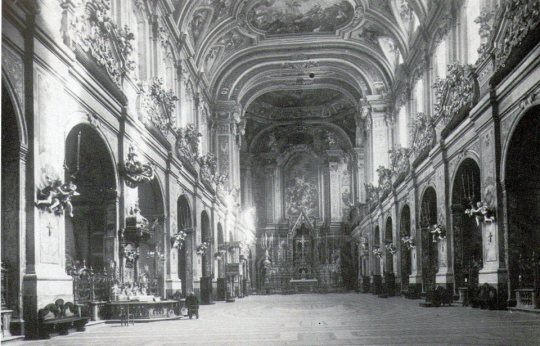
Terrible, I know. Those rococo vandals did worse damage than the modern graffiti artists, who desecrated only the outside of the church.
But help came in 1943, in the explosive form of allied bombers. After the RAF raids on Naples, the basilica looked like this.
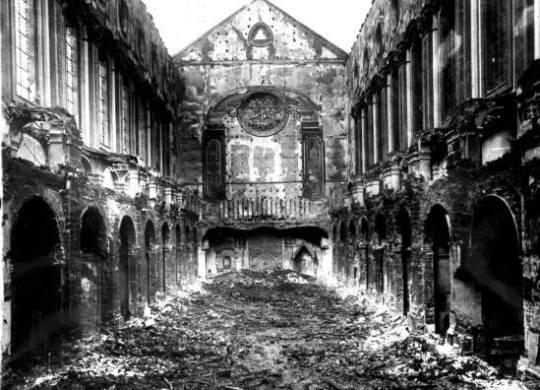
Following the war, the city council met to discuss reconstruction.
"We need to rebuild the original church," the mayor said.
"Hear, hear."
"Wait a minute," one communist councillor objected. "We can't afford gilded wood and marble. People are starving!"
"Who's speaking of gold?" the mayor said. "It would be an insult to Santa Chiara, who made a vow of poverty."
"But you said you wanted the rebuild the original!"
"Yes: the Gothic original."
There were gasps around the chamber. But the mayor carried the day with communist support, in an early instance of compromesso storico.
The result is this masterpiece:
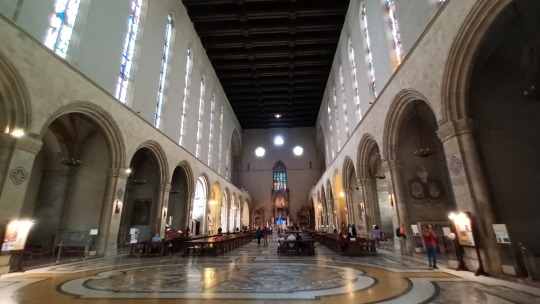
The stained glass windows, in particular, are stunning.
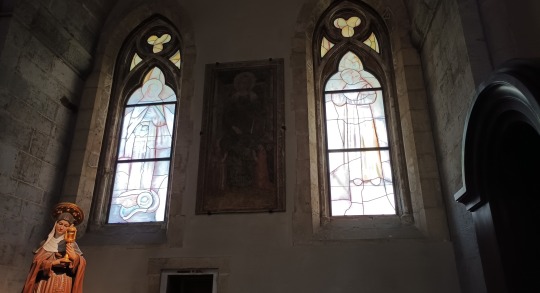
On the bottom left is a representation of Santa Chiara, whose remarkable story is told on a panel.
She was born in 1194 to a noble family. At the age of 18 she told her parents she had met an extraordinary young man called Giovanni.
"I need to know about this guy before you marry him," the father said.
"There is no question of a marriage. I want to follow him. He has dedicated his life to those less fortunate than us."
"That's what they all say."
Hoping to break down parental resistance, Chiara invited Giovanni for a chat at the family home in Assisi.
"So you want to feed the hungry, eh?" the father said.
"Yes."
"My daughter says you come from a good family."
"My parents are wealthy merchants."
"Hmm," the father muttered. "Those rich kids are often the worst."
It was not going well for Chiara.
"Francis," she cried. "Tell them you've renounced your family's fortune."
"I kind of did," the young man whispered.
The father startled.
"Did she call you Francis? I thought your name was Giovanni."
"To care for the destitute I go by the alias of Francis. It's my brand."
"WWWWait... Are you telling me you are Francis of Assisi?"
"You could call me that."
"Jesus Christ!"
"Giuseppe!" the mother exclaimed.
"I mean bloody hell. Ortolana: this is Saint Francis of Assisi!"
"Let's not get ahead of ourselves. I haven't been canonised yet."
"Why didn't you say so?" the father said.
"Well I don't go around like: ‘Guys, do you realise you're talking to Francis of Assisi?' That's just not my style."
So Chiara followed Francis, founded the Poor Clares order and spent the rest of her life feeding the hungry.
Leaving the basilica, we felt peckish ourselves. We assumed we'd get a quality lunch on the heights and took a bus going up to Capodimonte.
Previous entries on Naples:
1. Ryanair
2. Neapolis or Nablus?
3. Daylight robbery
4. Sybaritic afternoon
3 notes
·
View notes
Text
Hiking in the footsteps of the Heckerzug (part 1)
This past weekend, my boyfriend - a history enthusiast - and I did a multi-day hike in the southern Black Forest 🌲Schwarzwald🌲 that followed part of the route taken by revolutionary leader Friedrich Hecker and his armed civilian militia between April 13-20, 1848.
The history
The Badische Revolution was part of the broader revolutions of 1848 that took place across Europe, and it was the first to take place in Germany. The first chapter of Badische Revolution was an uprising known as the Heckeraufstand. It was led by radical democrat Friedrich Hecker with the intention of overthrowing the monarchy and establishing a Republic.
Hecker and his contemporary Gustav Struve (who had relinquished his aristocratic title) organized an armed civilian militia which set out from Konstanz on the Swiss border on April 13, 1848. This march is known as the Heckerzug, and its final destination was Karlsruhe, the ducal capital of the Grand Duchy of Baden (Großherzogtum Baden), where it was to join forces with another armed group, led by the revolutionary poet Georg Herwegh, which had set out from France. Revolutionaries Franz Sigel and Joseph Weißhaar also led civilian militias as part of the uprising that were to join up with the Heckerzug - none of them made it anywhere close to Karlsruhe, as you can see on the map below.

On April 20, the Heckerzug was halted by troops of the German Confederation (Deutscher Bund) just outside the village of Kandern, at a point known as Scheideck. Hecker survived the battle and fled to Switzerland (as did Struve), and later emigrated to the USA.
The hike (day 1: Lenzkirch - Bernau 21,6 km)
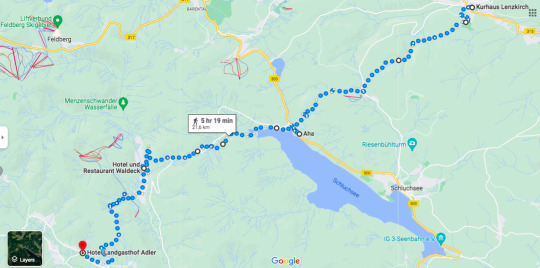

Our hike began on Friday morning. We had spent the night in Freiburg and took a train from there to Titisee, continuing to Lenzkirch by bus. The Heckerzug arrived there on April 17, 1848, and Hecker held a speech on the steps of the guesthouse Zum Rößle to encourage the locals to join his cause - he won over about a half-dozen men, and the Heckerzug continued onwards the same day.
From Lenzkirch, we first hiked 8,5 km along the Schluchtensteig over to Aha and around the western part of the Schluchtsee (the largest lake in the Black Forest) before continuing over the next ridge to Menzenschwand.

Part of the path from Menzenschwand over the next ridge was closed due to forestry work, and we considered taking a long detour around the ridge, but ended up bushwhacking our way up a semi-official path... right as we got to the top of the ridge, the thunder started, and we hurried down to Bernau. The storm rolled in quickly from the southwest, and we arrived in Bernau in the pouring rain, but we still managed to see the guesthouse Adler, where Hecker and his men were welcomed with a hearty meal back in the day.


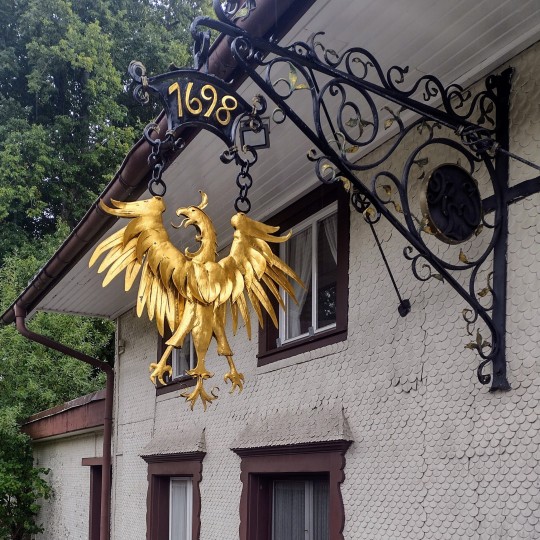
Spending the evening in Todtmoos
We hung out in Bernau for an hour before taking a local bus south to Todtmoos, where we stayed the night. The Heckerzug never passed through there, but Todtmoos was historically a pilgrimage destination due to its baroque pilgrimage church (Wallfahrtskirche). A supposed apparition of the Virgin Mary here in 1255 led to pilgrims from the Black Forest, northern Switzerland and the Alsace region to flock to Todtmoos during the Middle Ages to pray for an end to the Black Death. This was the beginning of the tourist industry in Todtmoos, and in the seventeenth century, several guesthouses were opened to accommodate pilgrims. The oldest is today's Hotel Maien, which opened its doors in 1622.
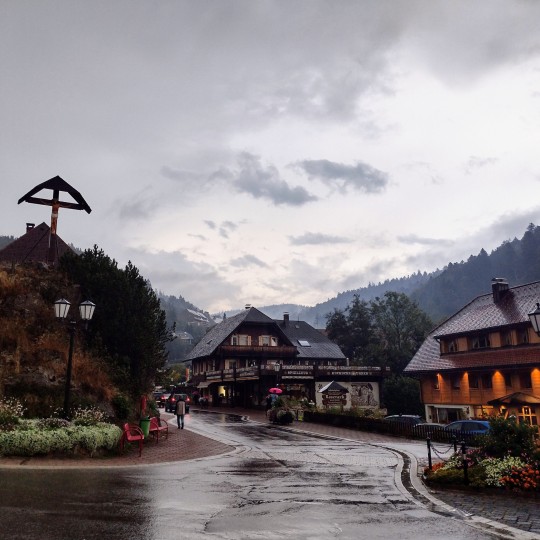
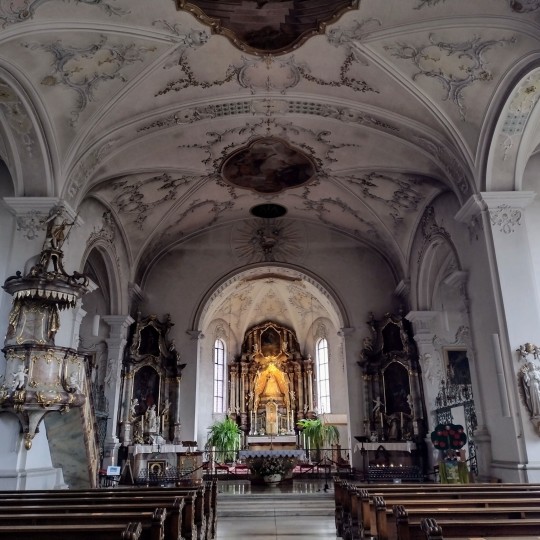
By the way, if you're thinking of opening up a restaurant or hotel in the Black Forest, might I offer some suggestions?
Rössle/Rößle: horse (dialect) 🐴
Krone: crown 👑
Adler: eagle 🦅
Hirsch: stag 🦌
Ochse: ox 🐂
Löwe: lion 🦁
Sonne: sun ☀️
Kreuz: cross ✝️
You see establishments with these names everywhere. Every town has a Rössle!
7 notes
·
View notes
Text
Veneto
On day 6 of our trip north we made it to Thiene, Veneto, a beautiful town at the foothills of the Italian Alps, just north of Vicenza. This was an opportunity to visit and reconnect with my cousins on (Dad’s side of the family), my aunt, and with Laghi, the small village from which my family emigrated many years ago.
Staying in central Thiene meant we could wander into the old town centre, past the Palazzo Porto Colleoni (built in the 15th Century), the Baroque style Cathedral, the old Romanesque-gothic church which dates back to 1333, and just experience the ambiance.



One afternoon we went for a late afternoon walk around the hills above Carrè which is north of Thiene and at the foothills of the mountains. We were greeted with stunning views over to the Gruppo Delle Piccole Dolomite, the Gruppo Pasubio and Monte Maggio.



The following day we were invited to join a group of Brazilian tourists for a history tour of Laghi. We met the group at the local trattoria in Laghi which is famous for its potato gnocchi and, after a good coffee, we headed off to the Molini contrada.
A little background information: Laghi is Italian for ‘lakes’ and we can probably attribute the name of the town to the existence of two small lakes in front of the main piazza. Laghi is Veneto's municipality with the smallest number of inhabitants and the lowest density. It comprises a number of small hamlets, or contrade, scattered over the valley and surrounding mountain side. The Molini contrada can be found behind the main piazza, at the base of Monte Maggio, one of the mountains which tower over the piazza. Monte Maggio lies next to the Pasubio group of Dolimites and the border of the Veneto province runs across the top of Maggio and over to Pasubio. Up until WWI, this was part of the border between Italy and Austria and during the war, it formed part of the Italian front along the Dolomites and Alps. I grew up hearing Mum’s stories of how the whole town of Laghi was told to evacuate one day, probably for several weeks and the war raged. They were able to return several years later to find the whole town devastated from the bombing.
Our tour of Molini was more focused on other aspects of living in Laghi during a time before the wars when everyone was largely reliant on the land. Interestingly, our guide advised us that no one went hungry during those days, with food being available from what they produced from the land, local products and flour and sugar bartered or bought from neighbouring towns.
We toured the old community cheese making ‘workshop’ in Molini where much of the equipment has been maintained. There used to be a number of these small community workshops spread across Laghi, including one where my grandfather, Giuseppe, made cheese with milk provided by the nearby families. Who would have known that cheese making was such a strong part of my family history! I asked what types of cheese were typically made and the response included Asiago cheese (a favourite of mine to make). Rather than press the cheeses they let them drain naturally and they used the leftover whey to make both butter and ricotta.
We also toured the old sawmill and viewed the old hydro system set up by a local to generate electricity which he then sold to the community. The latter was a very innovative initiative which the local set up and ran prior to the availability of electricity from the national grid. The system is still functional after all these years although it no longer supplies the community.
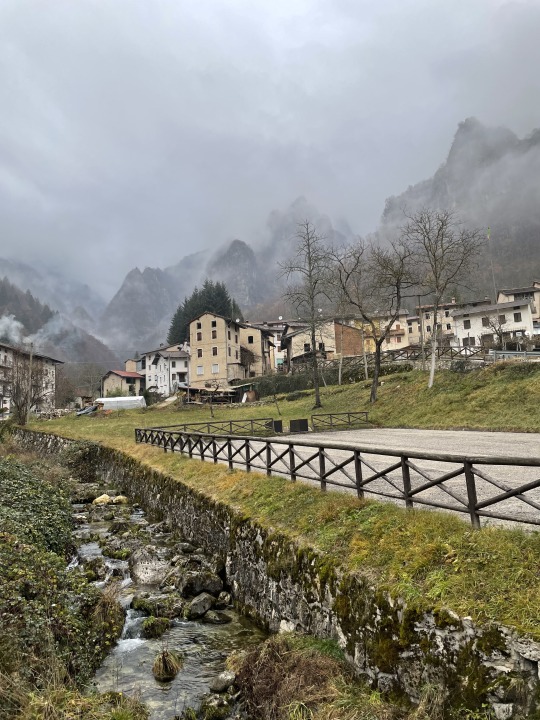
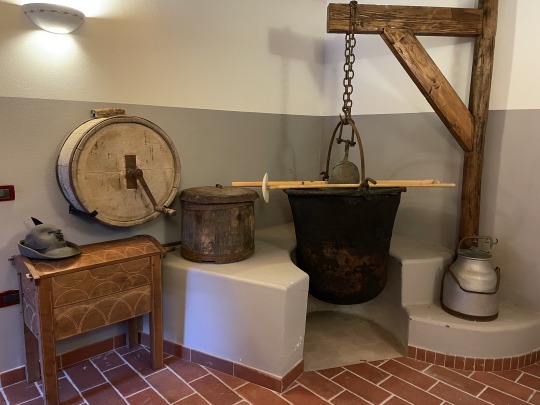
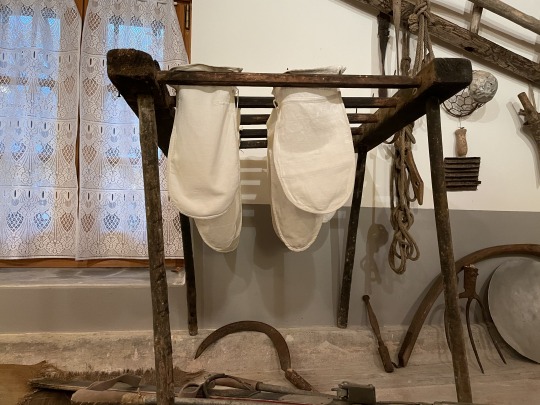

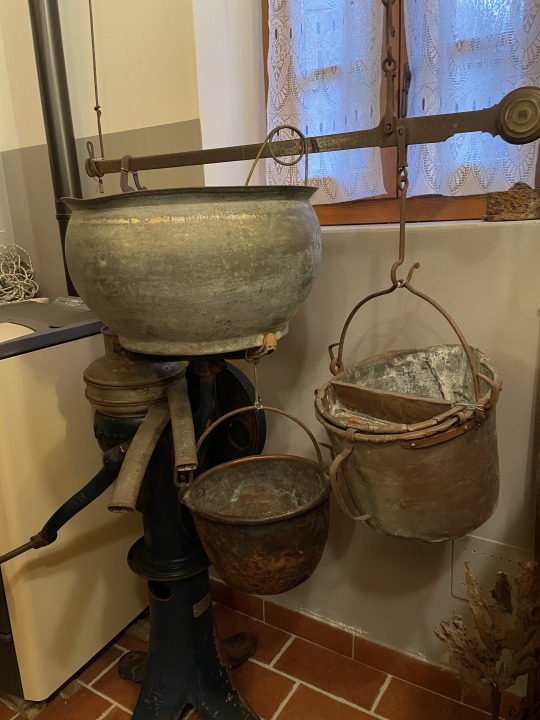
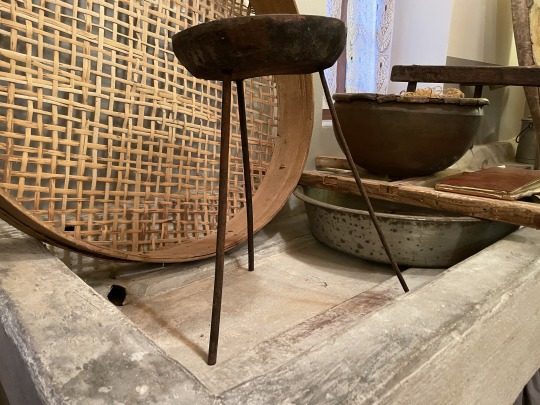


A little background information: Laghi is Italian for ‘lakes’ and we can probably attribute the name of the town to the existence of two small lakes in front of the main piazza. Laghi is Veneto's municipality with the smallest number of inhabitants and the lowest density. It comprises a number of small hamlets, or contrade, scattered over the valley and surrounding mountain side. The Molini contrada can be found behind the main piazza, at the base of Monte Maggio, one of the mountains which tower over the piazza. Monte Maggio lies next to the Pasubio group of Dolimites and the border of the Veneto province runs across the top of Maggio and over to Pasubio. Up until WWI, this was part of the border between Italy and Austria and during the war, it formed part of the Italian front along the Dolomites and Alps. I grew up hearing Mum’s stories of how the whole town of Laghi was told to evacuate one day, probably for several weeks and the war raged. They were able to return several years later to find the whole town devastated from the bombing.
Our tour of Molini was more focused on other aspects of living in Laghi during a time before the wars when everyone was largely reliant on the land. Interestingly, our guide advised us that no one went hungry during those days, with food being available from what they produced from the land, local products and flour and sugar bartered or bought from neighbouring towns.
We toured the old community cheese making ‘workshop’ in Molini where much of the equipment has been maintained. There used to be a number of these small community workshops spread across Laghi, including one where my grandfather, Giuseppe, made cheese with milk provided by the nearby families. Who would have known that cheese making was such a strong part of my family history! I asked what types of cheese were typically made and the response included Asiago cheese (a favourite of mine to make). Rather than press the cheeses they let them drain naturally and they used the leftover whey to make both butter and ricotta.
We also toured the old sawmill and viewed the old hydro system set up by a local to generate electricity which he then sold to the community. The latter was a very innovative initiative which the local set up and ran prior to the availability of electricity from the national grid. The system is still functional after all these years although it no longer supplies the community.
A little add-on for Allan and myself was a tour of the Comune Di Laghi and the council chambers. We saw the list of sindaci (mayors) from 1872 to 1999, including my grandfather (Guiseppe Dal Molin) and uncle (Attilio Dal Molin). Thank you Allan for the photos ….
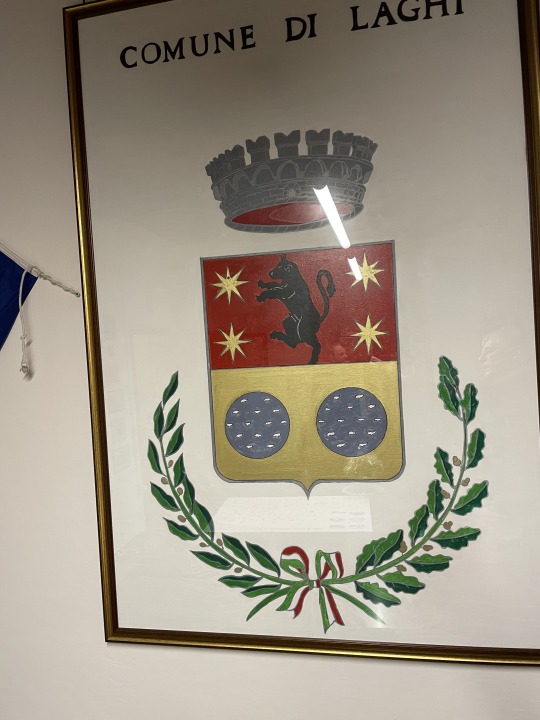
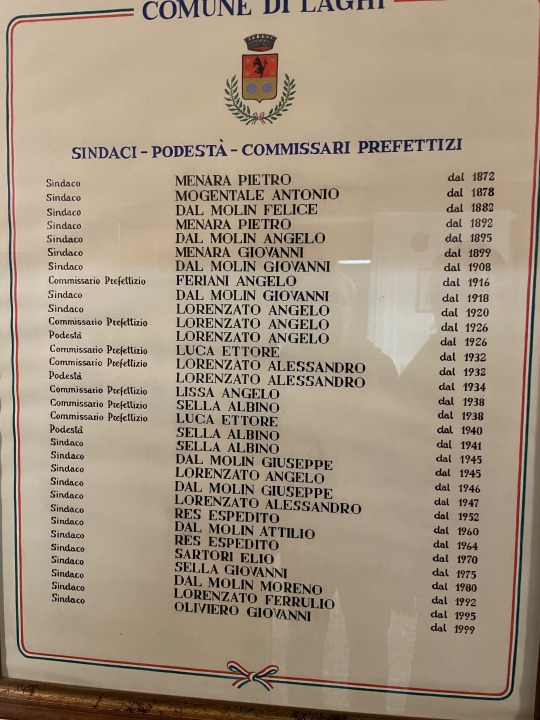
Back in Thiene, one of our last stops during this visit was to a local nursey which transforms into a Mercatino Di Natale each year. The displays were wonderful, with each section featuring a different colour theme for the tree and decorations. It was only the thought of minimal suitcase room and arriving back in Australia with a big box of broken glass that stopped me from buying a selection of baubles. Instead, I’ve set up a Christmas Table with two gnomes which a cousin has handmade (they are absolutely stunning), candles and books we’ve been given along the way. Now we’re back in Le Marche. Time to get back into walking and getting ready for next year. Damn, it’s raining again … think I’ll make a torta and curl up on the couch with my knitting.
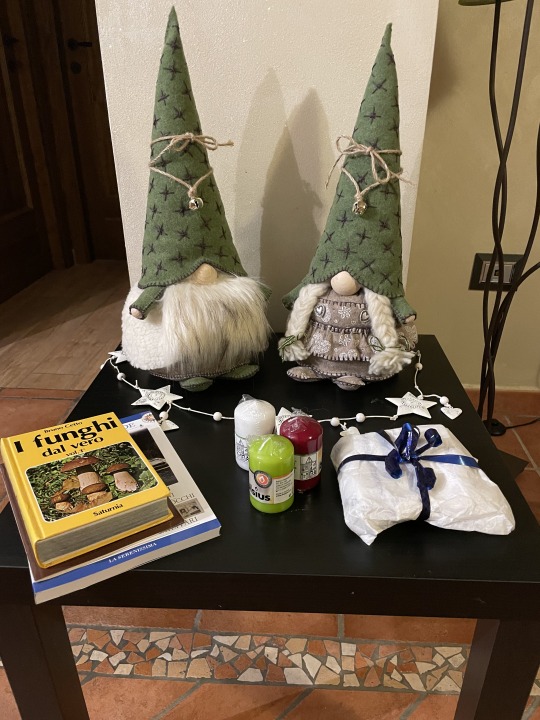
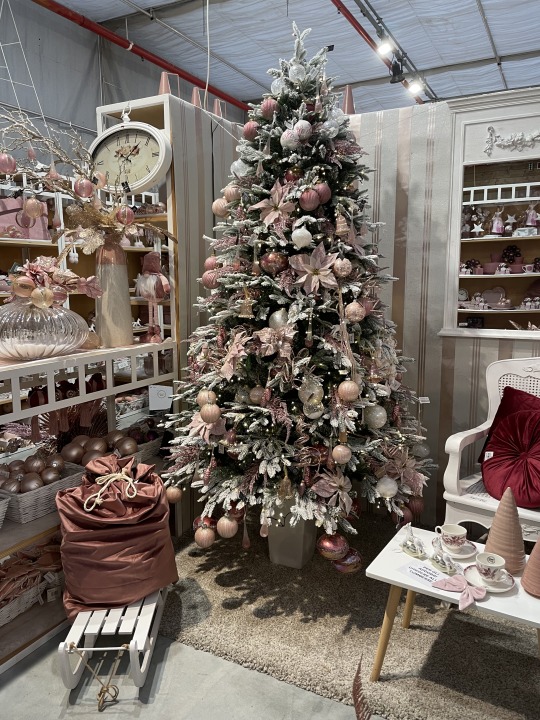
2 notes
·
View notes
Photo

Canon EOS 250D Taken on 19/04/2022. * Matera is a city of pale gold limestone, just over the border from Puglia in Basilicata. It has more layers than a sfogliatella pastry: its two cave districts, Sasso Barisano and Sasso Caveoso, are composed of individual dwellings carved into fossil-stuffed strata and stacked on top of each other like cells in a haphazardly constructed beehive. They were inhabited from prehistory until the 1950s, when — overcrowded, poverty-stricken and disease-ridden — they were evacuated by the state. Dubbed 'the shame of Italy,' Matera remained largely abandoned for decades—until in recent years. The best way to appreciate the city’s labyrinthine layout is on foot. Wandering the 'Sassi', visitors shouldn’t be surprised to find themselves standing on a 9th-century graveyard, across from an impeccable Baroque palazzo and above an 11th-century church-turned-family home, where 700-year-old frescoes still color the calcareous walls. Impactful, to say the least! 𝗛𝗼𝘄 𝘁𝗼 𝗴𝗲𝘁 𝘁𝗵𝗲𝗿𝗲: 🚆 Matera is reachable by train via Bari thanks to a service provided by 'Ferrovie Appulo Lucane'. ______________________________________ #Matera #Basilicata #Italia #Italy #EuropeanCapitalOfCulture #CapitaleDellaCultura #SudItalia #BestCityBreaks #CondeNastTraveller #LonelyPlanetItalia #RoughGuides #BasilicataBellaScoperta #Unesco #Basilicata_Mania__ #BasilicataTuristica #BestBasilicataPics #DiarioTricolore_Basilicata #Basilicata_Love #Basilicata_Cartoline_ #MateraItaly #MateraInside #SassiDiMatera #VivoMatera #VolgoMatera #VisitMatera #ThePrettyCities #ItalianHoliday #BasilicataDaScoprire #BasilicataPhotos #BasilicataDaAmare (at Matera, Italy) https://www.instagram.com/p/Ci4nmqWK_iU/?igshid=NGJjMDIxMWI=
#matera#basilicata#italia#italy#europeancapitalofculture#capitaledellacultura#suditalia#bestcitybreaks#condenasttraveller#lonelyplanetitalia#roughguides#basilicatabellascoperta#unesco#basilicata_mania__#basilicataturistica#bestbasilicatapics#diariotricolore_basilicata#basilicata_love#basilicata_cartoline_#materaitaly#materainside#sassidimatera#vivomatera#volgomatera#visitmatera#theprettycities#italianholiday#basilicatadascoprire#basilicataphotos#basilicatadaamare
3 notes
·
View notes